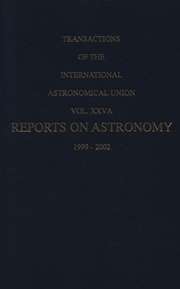No CrossRef data available.
Article contents
2. Physical State and Dynamical Processes
Published online by Cambridge University Press: 25 April 2016
Extract
It is now clear that the ISM does not consist solely of the classical three components, i.e., molecular clouds, diffuse clouds, and the intercloud medium (H II regions are discussed in section 7 of this Report). High-temperature, low-density components also exist. The role of the transition regions between these components has recently been emphasized, and dynamical processes, including interchange of matter between them and the role of stellar winds and supernova remnants, have been extensively studied. Review papers or general discussions have been given by Field (18.131.115); Salpeter (17.131.143); Kahn (18.131.116, concerning hydrodynamics and MHD); and Heiles (20.156.012, on interstellar magnetic fields). McKee and Ostriker (1975, Astrophys. J. 218, 148) have given a general theory of the ISM including a hot, diffuse component; they emphasize the role of the energy and momentum input from supernovae, the evaporation of cold clouds into the hot medium, and the role of heat conduction.
- Type
- Research Article
- Information
- Copyright
- Copyright © Reidel 1979


